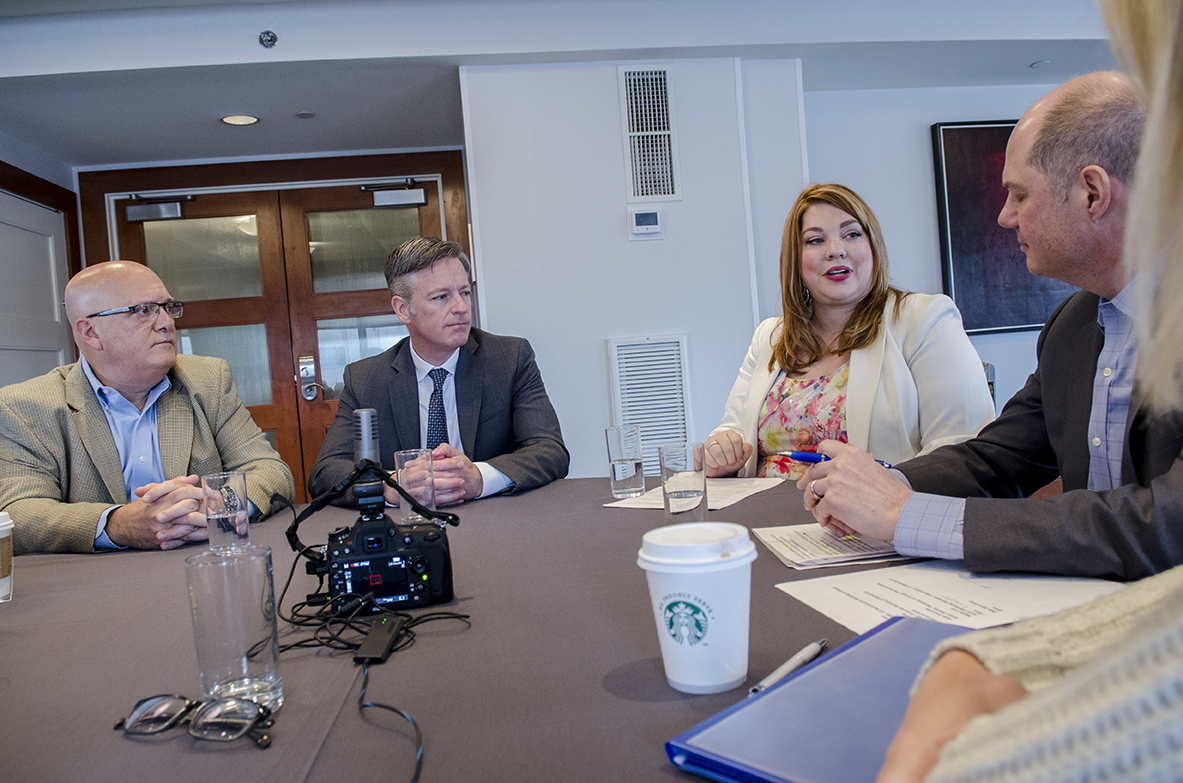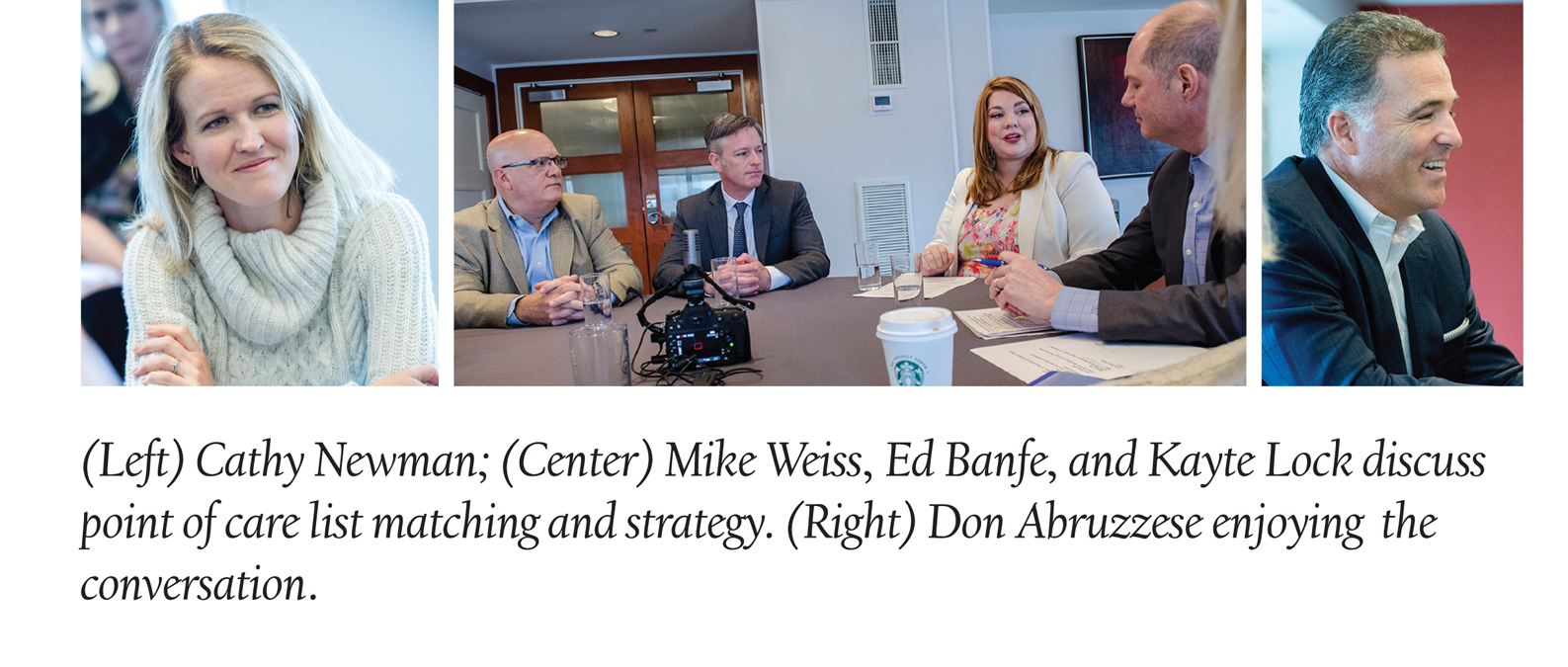Six industry professionals gathered recently to discuss the benefits of Point of Care, DTC, and the mix of tactics and strategies that are most effective in reaching and engaging patients, HCPs, NPs, PAs, and others in the business of improving patient lives and outcomes. Each addressed the value, successes, and best practices in the Point of Care space and its important position among the many DTC approaches, and the intricacies of ROI measurement to enhance not only brand awareness, but also provide the best value and outcomes—most importantly—for patients.
Moderated by Cliff Barone, President, Strategic Agility Group, participants included:
- Don Abruzzese, Consumer Lead, Neuroscience Franchise, Shire Pharmaceuticals
- Ed Banfe, Consumer Marketing Lead, Neurology, Mallinckrodt
- Julie Holcombe, Senior Director, Marketing, Synergy Pharmaceuticals
- Kayte Lock, Senior Brand Manager, Pfizer
- Cathy Newman, Associate Director, Allergan
- Mike Weiss, Vice President of Sales, Health Monitor Network
Cliff Barone: First and foremost, I want to thank everyone at the table, certainly PM360, Health Monitor, as well as the experienced marketers here. So, we’re here to discuss customer engagement at the point of care. What have been some of challenges, opportunities, and successes in the space?
A key issue has been relatively low point of care spend, yet a very targeted way to reach our customers. Could you speak in terms of spend and how you see point of care as a portion in your marketing mix?
Ed Banfe: Well if you use TV, everything else is going to be low because the cost of entry to TV is so huge. But I think another part of it is you get breadth and depth of engagement right? TV has a lot of reach but you don’t get that same depth of engagement. I think that’s the tradeoff. You might spend less as a percentage of your budget in point of care, but you get deeper engagement with it because it’s more targeted.
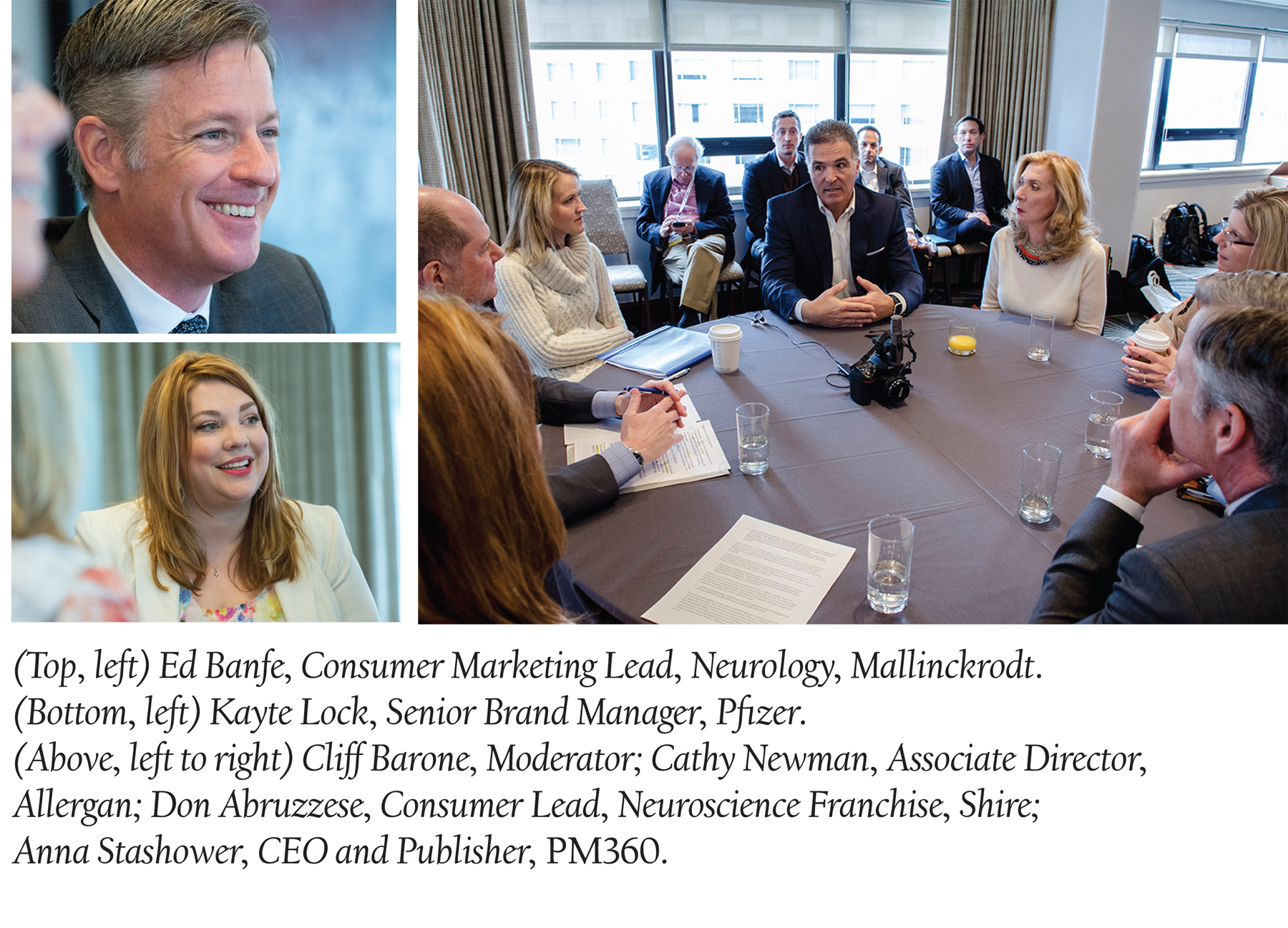 Julie Holcombe: I also think the scale is growing but there is still a limit to it, whereas other areas of spend have a little bit more depth and opportunity, but that’s okay. If done correctly the strategic approach should be that all the elements of DTC are working together. So you may start a conversation in other channels but by pulling through and paying it off in-office just before or immediately after the physician interaction. If you’re looking across your spend, everything becomes complementary and interconnected. Sometimes that means TV and print and sometimes it doesn’t. But the importance of in-office discussion is always there.
Julie Holcombe: I also think the scale is growing but there is still a limit to it, whereas other areas of spend have a little bit more depth and opportunity, but that’s okay. If done correctly the strategic approach should be that all the elements of DTC are working together. So you may start a conversation in other channels but by pulling through and paying it off in-office just before or immediately after the physician interaction. If you’re looking across your spend, everything becomes complementary and interconnected. Sometimes that means TV and print and sometimes it doesn’t. But the importance of in-office discussion is always there.
Don Abruzzese: I think point of care is very much in a nascent experimental stage right now. I think it’s going to grow much bigger than we might anticipate. It’s just going to take a while—there’s going to be a lot of experimenting. The trick is—which approaches are going to be really effective?
Cliff Barone: A related question, we’re seeing fewer and fewer big blockbuster drugs getting approved each year, and many newly approved drugs target small populations. With the targeting ability of point of care, and perhaps able to do a better job of reaching small disease populations, why aren’t we seeing the same growth in point of care that we are seeing in other channels, such as TV?
Julie Holcombe: Let’s say I’m in a rare disease category. That can be a really tiny target to find even in a specialty office. And when I do, we all want to buy out the category to lock out competition. But if I’m locked out, I’m going to have to go with a different route. So again, space is limited. But I love that point of care is growing and evolving and that there are different opportunities throughout the space—exam room or a waiting room or check-in. That growth is good for all of us, but it is still limited.
Kayte Lock: I think it’s also very category dependent. Thinking about your brand objectives from an ROI perspective, in some cases it doesn’t make sense to have a TV presence or be in print. And so I think in those situations, it further reinforces the value that point of care marketing provides.
Cliff Barone: Great. Don mentioned that point of care is still in its infancy. In your experience, do you agree and have you seen cost-efficiency advantages in leveraging point of care? What can be done to push the envelope to increase investment to help drive its evolution?
Kayte Lock: I think the role of point of care marketing also supports the physician in their practice. We know that waiting times are increasing. The time spent with the patient is decreasing. And so to be able to provide that educational support pre/post visit alleviates the physician from needing to have that conversation. So through that, we’re also gaining HCP support for the role pharma is playing in patient education.
Cliff Barone: So is it about looping that back to the organization so they really understand the value of point of care?
Kayte Lock: Absolutely. As I look at the patient check-in process, we’re helping the physician understand: What are the messages that the patient is receiving in that check-in process so that as they’re having the conversation, we’re helping to bridge that conversation?
Don Abruzzese: Definitely. As long as you’re solving a problem for either the physician or the patient or both they’ll welcome it. If you’re not offering value, they’re not going to engage. And that relationship is getting so much more complicated. There are so many more unknowns with the entire payer environment changing. So often you have to step in and help—especially to overcome misperceptions with regard to coverage and inconveniences that the patient might have.
Kayte Lock: We’re also seeing a lot of focus now to support the pharmacists, support the brand to avoid a reversal claim, and also to let patients know when their refills are available. So that’s supporting both conversion and adherence through retail. When you look at the ecosystem and the entire patient journey, I think there are so many opportunities that point of care marketing is now presenting for us.
Cliff Barone: So it sounds like there are still a lot of opportunities in the space potentially for things that aren’t offered right now that we could take advantage of. ROI was mentioned and it’s a constant challenge and continual process, certainly on the point of care side, as well as with other tactics we’re leveraging. What do you think can be done to improve the ROI process and what is your experience with that?
Julie Holcombe: ROI is such a loaded concept. The measurement approach has to include factors besides the cost per script. For example, what’s the interpretation by the patient, who may not end up with a script for your product right away, but gains a more positive impression of your brand because you support educational efforts. Or the opinion of the program by HCPs, especially those that we may not be able to engage with otherwise? Those kind of results can’t be measured by script activity.
So prescription impact is only part of that package. But when it’s time to measure just that piece, whenever possible I work with a third-party. The fact is we’re never going to feel like we’ve got 100% definitive proof of prescription impact unless there’s a clean test and control study.
Don Abruzzese: Yes. So often when we do an ROI analysis it’s discounted because it’s a different tool, especially if you’re using a third-party or you’re using a supplier that’s measuring what they’re doing. So it really gets down to how accurate is the actual analysis?
How independent is it? And how much can you rely on it? How detailed can you get? Point of care actually can be measured very, very accurately because it’s geographically located. You can do a test and control using some very powerful big data analytic tools. The more data you feed these types of tools—the more powerful and insightful the results. They also allow you to do them in-house by your own analysts.
Ed Banfe: Another thing you can do is just make sure your analytics plans are more comprehensive. So you’re not just measuring that result. But you’re also getting a sense of what the leading indicators are. So if you’re changing someone’s willingness to ask—just that person’s stated willingness—then you should view that as supporting the higher ROI. Or whenever you’re increasing the perception of efficacy in your product among HCPs or patients, you know that can support the ROI argument.
Kayte Lock: I would agree. I think you can trust the ROI even more coming from a point of care tactic because you know exactly which offices you put the tactic in. You know how many other tactics are in that office. And you can do a really good analysis.
Don Abruzzese: Yes. It’s more important that you were also analyzing it as part of a total marketing mix because there are certainly places where they complement each other.
Cliff Barone: Right. So what kind of ROI have you seen with point of care versus other channels. Is it the same, higher, lower?
Ed Banfe: I’ve seen it higher than TV, but it doesn’t have the same scale as TV. But that’s only one part of the picture. It’s not just the ROI, but how much of an impact does it have? How much revenue did it really generate? I have difficulty when I see a 17:1 ROI, which I have. I think my threshold for disbelief is somewhere around 8:1 or 9:1.
Don Abruzzese: Yes. Normally, it is not equally effective across every location. So some of these tools can actually tell you this 20% is really driving the ROI—and show areas with a negative ROI. That helps you then direct where you make your investment. And it’s not necessarily covering every single office. It’s putting your money where it actually is going to have an impact.
Julie Holcombe: That’s true, and along those lines, I do think the geographical aspect is one that we probably don’t leverage appropriately. We often buy against it but then don’t optimize it nearly enough. We may even run pilots to support too much or too little sales activity, but then tend not to take advantage of the learnings and scale accordingly. So I think the flexibility is there. We as marketers need to do a much better job of using it.
Cliff Barone: So, use in different offices was brought up. Are you using field target list-matching to cover physician offices within point of care efforts? Have you found that to be an effective way to leverage it?
Ed Banfe: Yes, there are certain places where you’re trying to get a patient to ask for a specific product. There are some places you know that that request is more likely to be granted than others. So you do it for that reason. But the payer landscape drives it, too. There are places where I want to run even if I’m not certain that the doctor will grant the script, because I know the product doesn’t require step edits in the geography.
Cathy Newman: The list matching is important because the correct placement makes the channel efficient—you’re putting your ads in offices that are prescribers or likely treat patients with your condition, versus the wide reach of television. It’s important to make sure the list match is accurate and you’ve prioritized the right attributes so you’re getting the right audience.
Cliff Barone: It’s really about opportunities for both breadth and depth within point of care and then optimizing the effort around managed care and other environmental issues. In brand planning, do you see point of care more as a strategy or a tactic?
Julie Holcombe: I love this question because there is not enough distinction between strategies and tactics. I think it’s both; it just depends on what aspect of it you’re talking about. The approach to using point of care is a strategy because it’s part of the decision of how and where to best meet the needs of your customers and where they’ll be the most productive for your brand. The actual physical piece that sits in the office is the tactic. So it goes back to breadth and depth: How you choose to purposefully use the reach of point of care—the strategy; and how to get your message across—the tactic.
Cathy Newman: I agree with that. A good overall strategy would be to have nuanced messaging in ads depending on the channel. Sometimes it’s easier, since the asset exists, to take a TV ad, which was created for wide reach and awareness, and place it in-office with a point of care tactic. But if we had created a video specifically for point of care, the message may have been more detailed to lead to a productive conversation with their physician.
Cliff Barone: I see there is agreement around the table. At the same time, does there need to be more internal sales around point of care? And if so, what can be done to elevate it to a strategic level or create an emphasis on that channel within your marketing plans?
Julie Holcombe: The allure of DTC is still television, and its high reach and visibility is naturally understood. For a brand that can afford TV, that’s an easier sell. But for others, or when just including point of care as part of the bigger mix, there’s less sexiness to it. So internally you have to create the understanding about engagement and motivation at the timeliest point of the treatment journey. Again, maybe not sexy—but a focused business driver.
Don Abruzzese: Well the beauty of point of care—so much of it is coming in as digital. You can really measure it. You can put those metrics in place and you can really see where it’s going. So you can manage that way.
Cliff Barone: So in terms of the patient, what specific marketing strategies do you find point of care is most effective with? Is it acquisition, conversion, compliance, adherence? What do you think is most effective at delivering?
Julie Holcombe: I think the natural association is around conversion because the call to action to speak with an HCP can be instantly realized. But depending on your placement, your message, and your action driver, point of care can be used for any objective along the journey. For example, a pharmacy program may have a much different strategy than an in-office program. There may even be differences between exam rooms versus waiting room programs. But I think what attracted us all initially was the conversion aspect and the immediacy of that decision point.
Kayte Lock: I am seeing an increase in geo-targeted adherence support. So we want to make sure that cost isn’t a barrier for the patient and want to be able to deliver that message when they are at that point of refill through a variety of different mediums, whether it is text messaging or email.
Julie Holcombe: I love geo-targeting across the customer journey. We can use it anywhere, but especially through mobile technology targeting delivery in the office or pharmacy, or as Kayte described a follow up for adherence. It has its limitations, but overall it’s an opportunistic channel that we’re not tapped into enough yet as an industry. It’s underappreciated —which amazes me given the penetration of smartphone use across our customer segments.
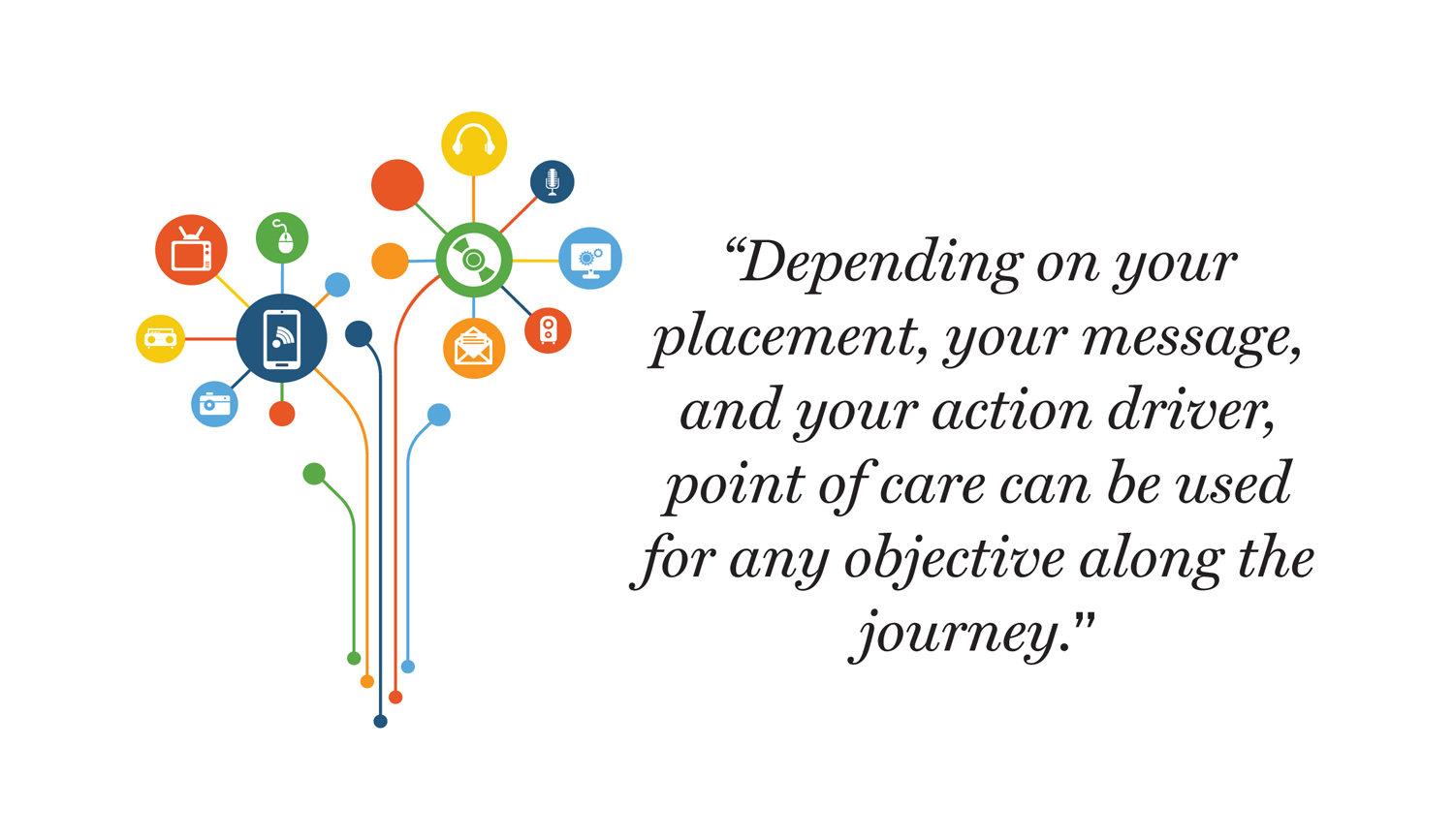 Don Abruzzese: Mobile first is a completely different approach because the amount of power and resources of a mobile phone—well, there’s so much capability. And if 85% of my target is interfacing on a mobile phone, I might even argue I don’t need a desktop version of it because it’s only 15% of my target.
Don Abruzzese: Mobile first is a completely different approach because the amount of power and resources of a mobile phone—well, there’s so much capability. And if 85% of my target is interfacing on a mobile phone, I might even argue I don’t need a desktop version of it because it’s only 15% of my target.
Ed Banfe: Well, when you combine mobile first with geo-targeting you can start doing interesting things. You can make assumptions about where your customer is, if they’re in the physician’s office. So you could send very targeted messages.
Kayte Lock: But then how do you also adjust for the consumption in how that information is being received on the different formats—desktop versus mobile? All too often we see our agencies giving us one size fits all creative. So that’s something that we continue to challenge our agencies to deliver on.
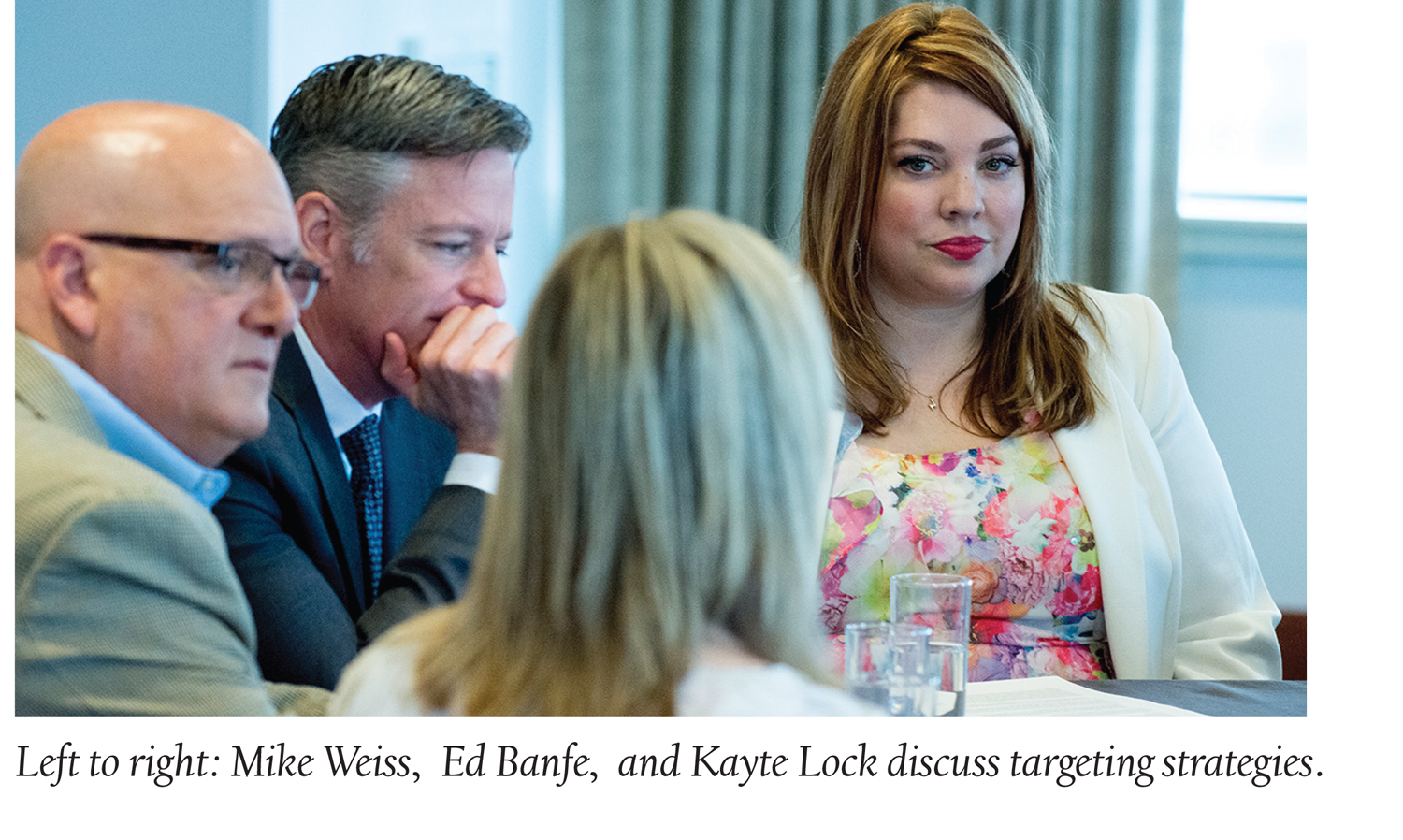 Cliff Barone: The scalability issue was brought up earlier. Have you seen this as either a positive or a negative? And what’s been your experience in terms of scale within the point of care channel?
Cliff Barone: The scalability issue was brought up earlier. Have you seen this as either a positive or a negative? And what’s been your experience in terms of scale within the point of care channel?
Don Abruzzese: A lot of digital solutions are scaling up quickly. So what you’re doing is investing in the future of it as we are learning about it at the same time. One benefit is that since it is a new space, you like to pilot test—and fail fast. So you, almost by definition, are in a smaller universe. And you can make some mistakes and it’s not costing you very much. But you’re learning.
Julie Holcombe: Part of the scale equation is the experience and willingness of the physician’s office to use these programs and related technologies. The scale issue is that there is a limit to how many offices there are, which is somewhat of a negative. But the growth within the space and being able to leverage different approaches or different partners in a concentrated area can be very positive.
I have sometimes heard from customers, “I don’t like this or that particular technology or vendor.” I’m not always hearing that played back from my vendors though. Instead the conversation can focus too much on how big the footprint is versus how we can make the most of what we have in the space while respecting how customers want to interact. For me, being able to best serve my customers and my business by leveraging flexible and diverse programs is the most important factor.
Cliff Barone: That makes sense. I’m wondering what kind of impact you’re seeing with point of care tactics versus other parts of the DTC mix. And how does the spend and the return compare? If you have any examples that you’d like to share, that would be terrific.
Julie Holcombe: Well, it’s not just an apples to apples comparison. It’s similar to the concern I’ve heard around not spending enough in point of care, but continuing to spend a lot in other channels. The type of spend you need in each channel is different, and so is how we assess impact. It’s really not about one versus another. It’s about the complete story I’m trying to tell, the complete experience I want my customers to have, and how well each channel is contributing to driving that experience.
Cathy Newman: And I agree. The great thing is point of care is growing. There are a lot of new companies with interesting technology and creative platforms. But sometimes a new point of care company doesn’t have enough of our priority offices. For a product with a narrow indication it doesn’t make sense to start working with them if your patients aren’t in those locations. So, I may want to work with the vendor, but for us, we may have to wait until that vendor’s network gets a little bigger.
I consider the cost of the advertising contract with the vendor and also the cost to create a new ad for that platform. It’s not worth coming up with a new creative, unique to that platform, if that message can only get to a small percentage of the right audience.
Cliff Barone: So let’s talk about working back and forth with agencies. What’s your thought on the planning process for POC and working with your agencies? And does it fit into planning the other DTC channels? Or is it separate? If you could talk to that it would be great.
Ed Banfe: One of the issues I see is on the creative agency side: They don’t always understand how they can design to point of care. And then on the media agency side: They don’t always understand how they could recommend leveraging POC, how they should work with the creative agency.
Don Abruzzese: The agencies are not looking at it from an engagement perspective. It’s not advertising. It is an engagement strategy. There should be a back and forth. I haven’t found the agency that knows how to do this yet or who is even trying proactively.
Kayte Lock: That’s why I think it’s incumbent upon us as marketers to make sure that we’re bringing in each of the respective parts of the process to the table to look holistically at the patient journey and leverage their different experiences to be thought partners in figuring out where the placements are best suited.
Don Abruzzese: But maybe it’s the players that are deploying this technology that have to actually take on some of that responsibility. It would be different for different disease states because you have different things you’re trying to accomplish. Their competitive advantage will be based on how much more sophisticated they can deliver that engagement versus their competition and deliver that value add. That’s going to take some time but that’s where I see it happening.
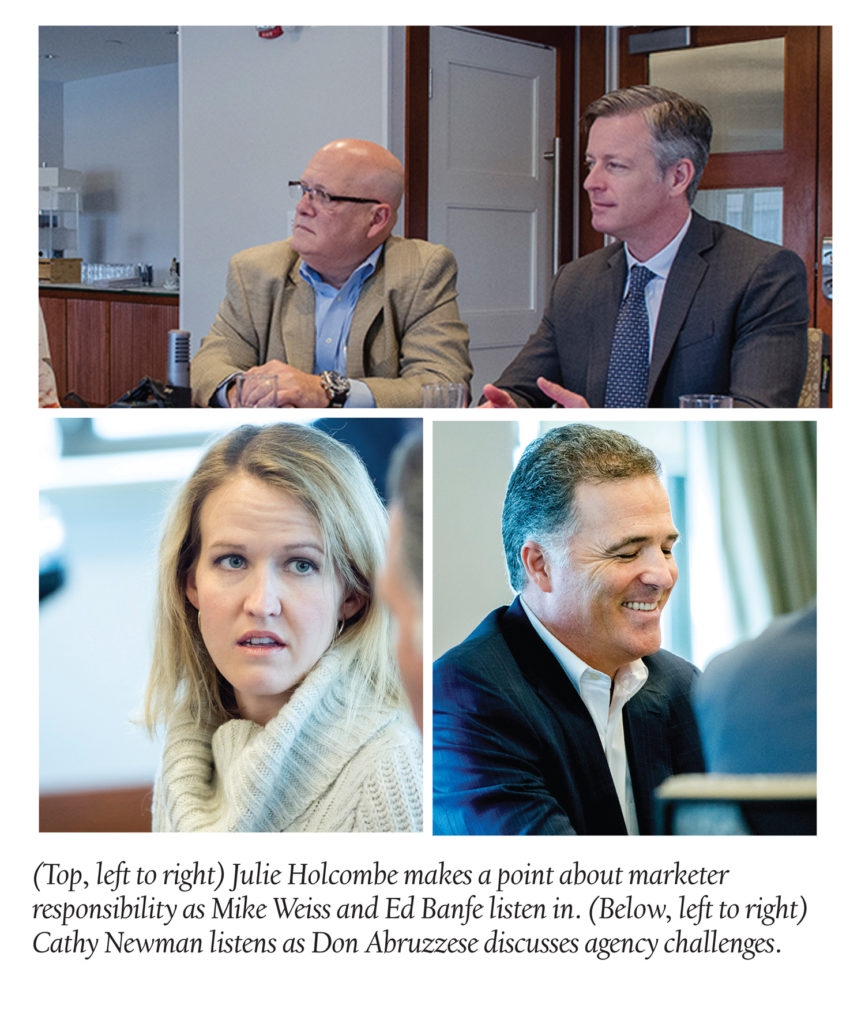 Cliff Barone: So you are talking about the vendors working more closely to educate the agencies about their offerings.
Cliff Barone: So you are talking about the vendors working more closely to educate the agencies about their offerings.
Ed Banfe: But then, even absent the agencies, the point of care vendors are sometimes better at understanding the application in specific therapeutic areas.
Julie Holcombe: Yes. The point of care vendors understand their customer and our customer best in terms of what’s going on in that space. We should be listening to them much more closely and, in particular, our agencies—both media and creative—need to pay more attention as well. Plus, the combination of these partners know our customers a whole lot better than any TV vendor will. We need to take more advantage of this knowledge.
Bringing these partners to the table together as part of the strategic discussion is important for us as marketers to try to do. And everyone sitting at the table should be aware of what we’re trying to achieve so that we can all work together to think about how best to creatively engage our customers across all channels.
We would like to thank our sponsor, Health Monitor Network, for making this event possible. The opinions expressed by the authors in this section are their own and do not necessarily reflect those of their affiliated companies or organizations.

